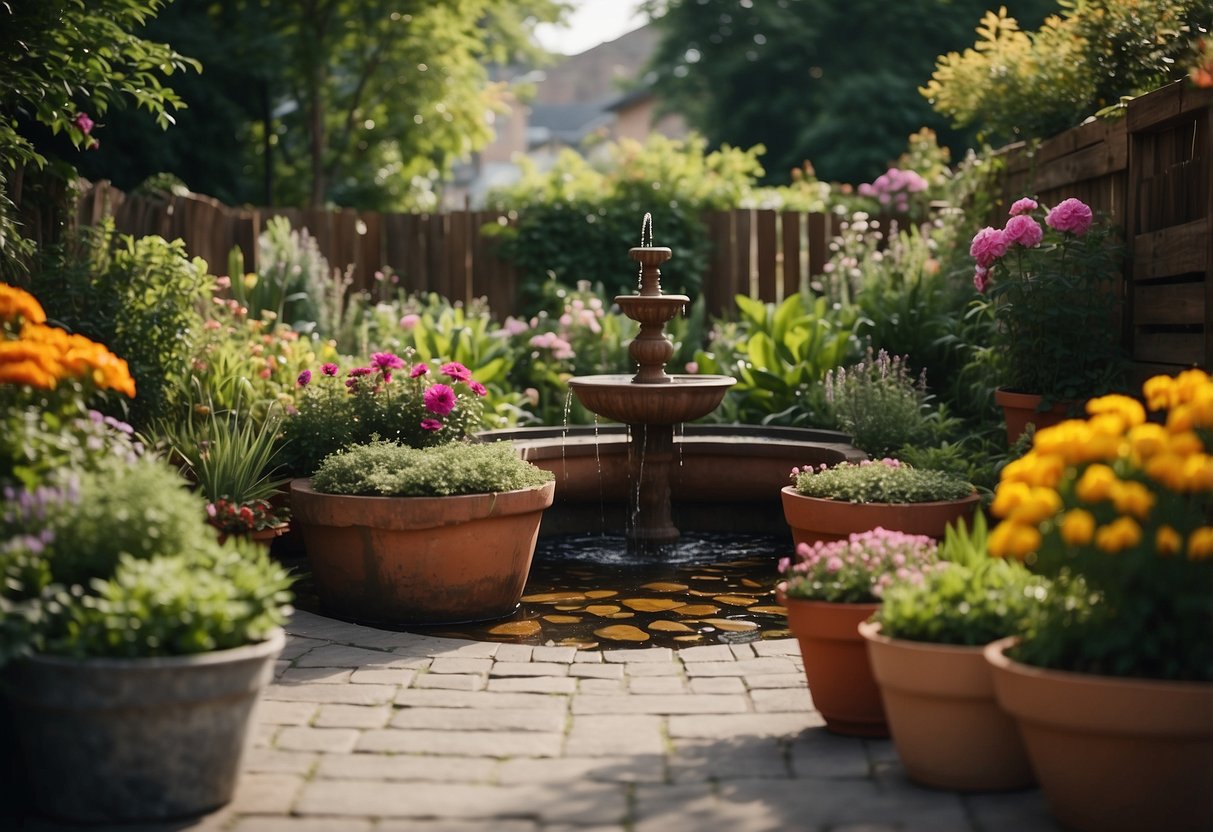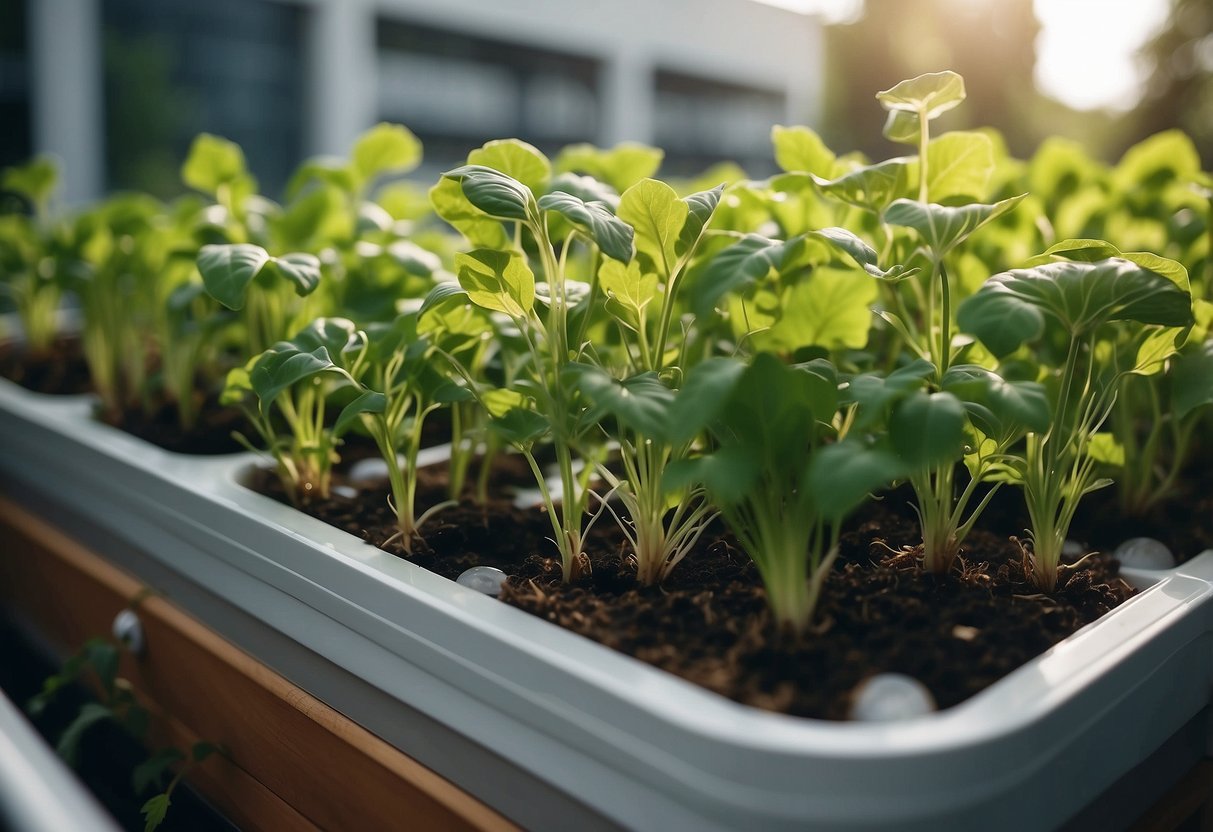Small Urban Garden Ideas: Stylish Tips for Limited Spaces
Living in the city doesn’t mean you have to miss out on the joys of gardening. Small urban gardens are perfect for transforming even the tiniest spaces into green oases where you can relax and unwind. Whether you have a balcony, terrace, or a small backyard, there are countless ways to create a vibrant and thriving garden that fits your lifestyle.

Discover how you can maximize your limited space with clever design and creative ideas. From using planters and mirrors to selecting the right plants, these tips will help you make the most of your urban garden. Embrace the beauty of nature with a small garden that brings life and tranquility to your busy city life.
1) Vertical Wall Gardens

Vertical wall gardens are perfect if you have limited space. You can use a variety of containers, like terracotta pots or wooden boxes, to create a green wall.
Try using a simple wooden trellis to support climbing plants like peas or roses.
Another idea is to build planter boxes into a fence for a seamless look. This way, you can maximize space and add charm to your garden.
2) Herb Spiral

A herb spiral is a fantastic way to add both beauty and functionality to your small urban garden. This compact, vertical design lets you grow a range of herbs in a limited space.
You can plant sun-loving herbs like rosemary and thyme at the top. Shadier, more moisture-loving herbs like parsley and chives can go at the bottom.
Use larger stones at the base and smaller ones at the top to create a stable structure. Fill in the gaps with gravel or rubble for added stability. A herb spiral not only maximizes space but also creates a stunning focal point in your garden.
3) Hanging Planters

Hanging planters are perfect for small urban gardens because they save space and look great. You can use them to grow flowers, herbs, and even small vegetables.
They are easy to hang on walls, fences, or balconies. You can get creative with different styles and colors to match your space.
Using hanging planters is a fun way to bring greenery to your urban home. For more inspiration, check out these vertical gardening ideas.
4) Miniature Wildflower Meadow

Creating a miniature wildflower meadow in your urban garden can be a joyful project.
Start by placing plants close together, fewer than 12 inches apart. Layer them by starting with low or ground cover plants. Then add midlayer plants that are 2 to 3 feet tall. Finally, include flowering plants that reach 3 feet tall or higher, including small shrubs and trees.
Using wildflower plug plants can also be easy. They can be placed straight into an existing lawn, even if it has weeds. These weeds can actually become part of your new meadow, blending in beautifully.
Adding height to your garden is another idea. Opt for plants like purple wild marjoram, spiked speedwell, blue field scabious, and red campion. These will not only add color but also attract butterflies and bees.
Consider leaving areas of your garden to grow wild. This can help create a more natural look and feel. Plus, it’s great for wildlife, providing habitats and food sources for various creatures.
5) Recycled Pallet Garden

Using recycled pallets for your urban garden is a fantastic way to save space and resources. Pallets can be turned into vertical gardens by securing pots or attaching fabric pockets to the slats. This method works great for herbs and succulents, offering easy access and a unique look.
You can also paint the pallets to add color to your garden. Popular herbs like rosemary, basil, and mint thrive well in pallet gardens. This approach makes urban gardening simple and stylish. Explore more ideas from One Kindesign.
6) Self-Watering Pots

Self-watering pots are a fantastic option for busy urban gardeners. They have a built-in water reservoir that keeps your plants hydrated without constant attention.
These pots use a wick or similar mechanism to draw water up into the soil from the reservoir. This ensures your plants get just the right amount of water.
You can even make your own self-watering planters using items like buckets and bottles, which makes it a cost-effective solution. These DIY self-watering planter plans are easy to follow and can transform your gardening experience.
7) Bonsai Trees

Bonsai trees are perfect for small urban gardens. They bring a touch of nature into tight spaces and are easy to care for.
You can display them on your patio or windowsill. Use vertical elements like shelves to showcase multiple trees. This creates a striking visual effect and saves space.
Some good options for outdoor bonsai include junipers, elms, and maples. These trees are low-maintenance and thrive in sunny spots.
8) Tiered Plant Stands

Tiered plant stands are a great way to maximize space in a small urban garden. By stacking your plants vertically, you can fit more greenery into a limited area.
You can make a tiered stand using materials like wood or metal. Repurposing items like old shelves or trays also works well.
For a fun DIY project, try creating a terracotta pot stand by stacking pots of different sizes. This not only looks charming but also helps save space.
9) Aquaponic Systems

Aquaponic systems are perfect for small urban gardens. They combine fish farming and hydroponics, letting you grow plants and raise fish together.
You can set up a media-based aquaponic system with materials like gravel or clay pebbles for plant support.
For a compact option, try an IKEA-hack system using wire baskets. It’s ideal for apartments.
These systems can be built cheaply with second-hand materials and basic tools like a drill and hacksaw. They’re a fun, eco-friendly way to garden.
10) Trellis for Climbing Plants

One of the best additions to your small urban garden is a trellis for climbing plants. It not only adds vertical interest but also maximizes the use of space by allowing plants to grow upwards.
You can choose climbing plants like jasmine, wisteria, or climbing roses. These plants can transform a simple trellis into a lush, green sanctuary.
Consider a metal grid trellis for an industrial look or a trellis with a planter box base for added functionality. This can make your garden both beautiful and efficient.
Getting Started with Small Urban Gardens

Small urban gardens require careful planning and smart choices to make the most out of limited space. Selecting the right plants and understanding the light and space needs are crucial for success.
Choosing the Right Plants for Urban Spaces
When starting a small urban garden, choose plants wisely. Compact plants like herbs, salad greens, and dwarf varieties of vegetables are great options. Vertical gardening can also save space by using trellises for climbing plants like beans and peas.
Consider using containers and planters that fit your space. For example, hanging baskets for strawberries or small pots for herbs can maximize your planting area. Succulents and cacti are also excellent choices as they require minimal care and can thrive in small pots.
Mixing flowers and vegetables can not only save space but also improve pollination and reduce pest problems. Marigolds, for example, can deter many common garden pests.
Assessing Sunlight and Space Requirements
Observe your space to understand how much sunlight it receives throughout the day. Most vegetables and flowers need at least 6 hours of sunlight. If you have limited sunlight, grow shade-tolerant plants like lettuce, spinach, and some herbs.
Measure your garden area to know how much room you have for each plant. Ensure you leave enough space for roots to grow. Plants may also need air circulation to prevent fungal diseases.
Create a garden layout plan. Using a grid or diagram, map out where each plant will go based on its sunlight and space needs. This will help you organize efficiently and ensure each plant gets what it needs to thrive.
With these tips, your small urban garden can transform into a lush, productive space.
Creative Urban Garden Design Tips

Designing a small urban garden can be both fun and rewarding. You can maximize your space with vertical gardening, utilize container gardening, and add edible plants for a touch of practicality and beauty.
Vertical Gardening Solutions
Using vertical space is key in small urban gardens. Wall-mounted planters are excellent for growing herbs and succulents. They save floor space and add a modern touch.
Trellises and climbing plants like ivy or jasmine can create a lush, green backdrop. You can also use shelves and ladders to stack potted plants vertically. This method works well for flowers and small vegetables.
Hanging baskets provide another effective solution. They are great for trailing plants like ferns or petunias. Mirrors strategically placed on walls can give the illusion of more space by reflecting light and greenery.
Container Gardening for Small Spaces
Containers are versatile and perfect for urban gardening. From terra cotta pots to wooden boxes, they let you grow various plants in limited areas. Place them on balconies, patios, or even windowsills.
Choose containers with proper drainage holes to prevent waterlogging. Lightweight materials like plastic or fiberglass make them easier to move if needed. Grouped containers can create a mini garden oasis, providing a burst of color and texture.
Raised beds made from repurposed materials are another option. They provide a dedicated growing area and can be customized to fit any space. Use multi-level plant stands to add depth and dimension, making your garden visually appealing.
Incorporating Edible Plants into Your Design
Growing edible plants adds functionality to your garden. Herbs like basil, mint, and rosemary are easy to grow and can be used in cooking. Vegetables such as cherry tomatoes, peppers, and lettuce thrive in small spaces.
Fruit-bearing plants like strawberries or dwarf citrus trees can add both beauty and a fresh food source. Companion planting is another effective technique. Pairing plants like tomatoes with basil can help them grow better together.
Consider a vertical herb garden using wall-mounted pockets or a small raised bed for veggies. This not only maximizes space but also makes it easy to harvest fresh ingredients for your meals.
Maintenance Tips for Urban Gardens

Maintaining an urban garden requires proper watering techniques and appropriate soil and fertilizer management to ensure healthy plants.
Watering Techniques for Small Gardens
In small urban gardens, watering is crucial. For best results, water at the base of plants rather than from above. This helps prevent mildew and other diseases. Drip irrigation systems can be effective, as they deliver water directly to the roots.
Frequent but shallow watering can harm plants, so aim for deep watering. This means watering until the soil is moist several inches down. You can check this by sticking your finger into the soil. Mulching around plants can help retain moisture and reduce the need for frequent watering.
Plants in containers or raised beds may need more frequent watering, as these environments can dry out faster, especially in hot weather.
Soil and Fertilizer Management
Healthy soil is the foundation of a successful urban garden. Regularly test your soil to know its pH and nutrient levels. You can purchase soil test kits from garden centers or online.
Composting kitchen scraps and garden waste is a great way to enrich your soil naturally. Adding compost improves soil structure, drainage, and nutrient levels. You should mix the compost into the soil at the beginning of the planting season.
For ongoing growth, use a balanced, slow-release fertilizer every few weeks. Container plants may require more frequent fertilizing than in-ground plants, as nutrients can leach out with regular watering. Always follow the instructions on the fertilizer package to avoid over-fertilizing, which can damage plants.







